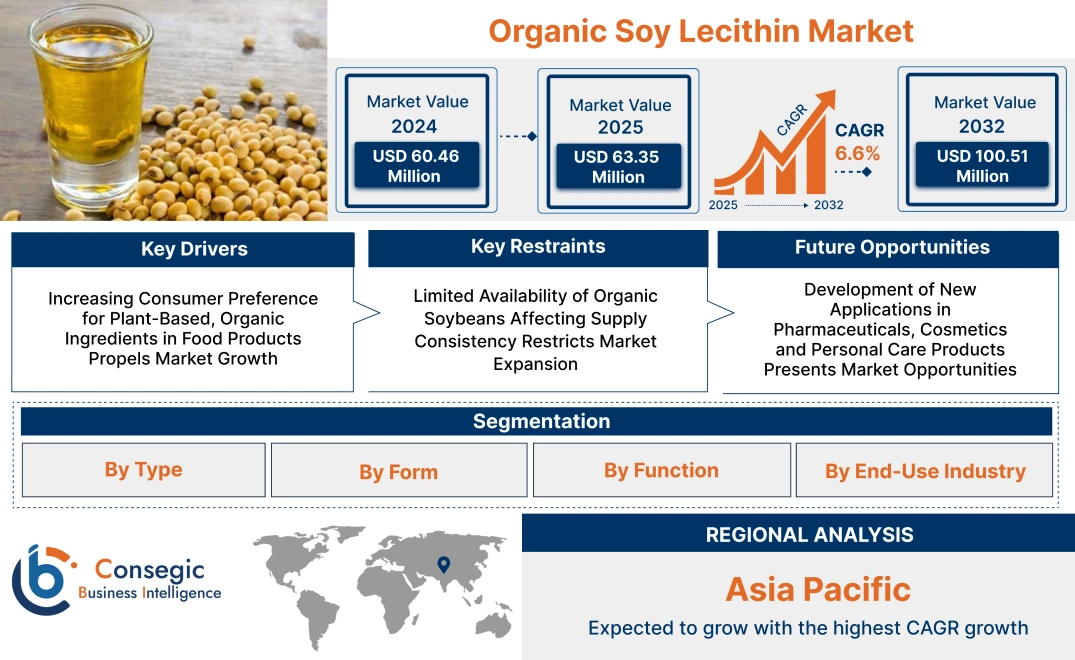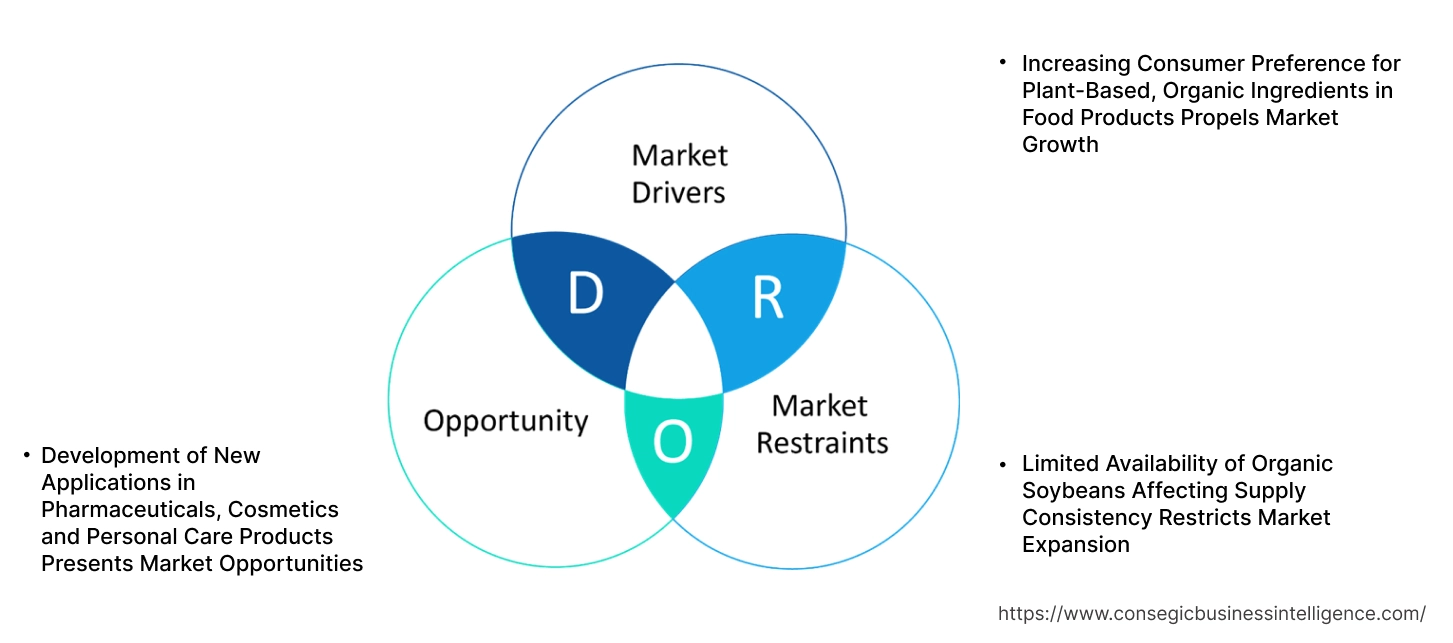Organic Soy Lecithin Market Size:
Organic Soy Lecithin Market size is estimated to reach over USD 100.51 Million by 2032 from a value of USD 60.46 Million in 2024 and is projected to grow by USD 63.35 Million in 2025, growing at a CAGR of 6.6% from 2025 to 2032.
Organic Soy Lecithin Market Scope & Overview:
Organic soy lecithin is a natural emulsifier extracted from non-genetically modified soybeans using chemical-free processes, widely utilized in food, pharmaceutical, and cosmetic applications. It serves as a stabilizing agent, helping to blend ingredients that typically do not mix, such as oil and water.
Key characteristics include high phospholipid content, excellent emulsification properties, and compliance with organic certification standards. It is available in liquid, powder, and granule forms, allowing flexibility in formulation across different product categories.
Organic soy lecithin enhances product texture, extends shelf life, and supports clean-label initiatives by replacing synthetic additives. In foods, it improves mouthfeel and consistency; in supplements, it aids nutrient absorption; and in cosmetics, it promotes skin hydration and product stability. Its plant-based origin and versatility position it as a preferred ingredient for brands targeting natural, sustainable, and health-focused consumer segments across global markets.
Organic Soy Lecithin Market Dynamics - (DRO) :
Key Drivers:
Increasing Consumer Preference for Plant-Based, Organic Ingredients in Food Products Propels Market Growth
The demand for plant-based organic ingredients is growing rapidly as consumers become more health-conscious and environmentally aware. Organic soy lecithin, a plant-derived emulsifier, is gaining popularity in the food industry due to its natural origin and numerous health benefits, such as supporting heart health, improving liver function, and acting as a natural antioxidant. As more consumers shift toward vegan, non-GMO, and clean-label products, the preference for organic soy lecithin in food products, especially in bakery, dairy, and confectionery items, continues to rise. This growing awareness is pushing manufacturers to adopt organic alternatives, driving the market. With increasing requirement for healthier and more sustainable food choices, the organic soy lecithin market expansion is accelerating, offering new opportunities for growth in the food and beverage sectors.
Key Restraints:
Limited Availability of Organic Soybeans Affecting Supply Consistency Restricts Market Expansion
The organic soy lecithin market faces challenges in maintaining a steady supply of raw materials, particularly organic soybeans. Organic farming practices are more resource-intensive and yield lower crop volumes compared to conventional farming, making organic soybeans less available. The limited availability of these beans can lead to fluctuations in supply, which in turn affect production. This supply inconsistency creates hurdles for manufacturers, especially when demand spikes, and it contributes to its higher costs. As the need for organic products continues to grow, the reliance on a limited supply of organic soybeans could restrict growth and lead to price volatility. Despite the growing necessity, these challenges limit the organic soy lecithin market growth by impacting its scalability and availability.
Future Opportunities :
Development of New Applications in Pharmaceuticals, Cosmetics and Personal Care Products Presents Market Opportunities
Organic soy lecithin, with its natural emulsifying, stabilizing, and moisture-retaining properties, is expanding its application beyond food and beverages into the pharmaceuticals, cosmetics, and personal care industries. In pharmaceuticals, it is increasingly being used as an excipient to enhance drug solubility and bioavailability, offering an effective delivery mechanism for active ingredients. In cosmetics and personal care products, lecithin is valued for its ability to hydrate, smooth and maintain skin elasticity, making it a popular ingredient in lotions, creams, and serums. The demand for clean-label, eco-friendly, and plant-based ingredients in these industries is driving its growth in new markets.
- For instance, From Nature With Love sells organic soy lecithin powder for personal care applications through their online store in the bulk format.
As these industries look to improve their formulations with natural and sustainable ingredients, the organic soy lecithin market opportunities are expanding, positioning the product as a key ingredient in non-food applications.
Organic Soy Lecithin Market Segmental Analysis :
By Type:
Based on type, the market is segmented into refined and unrefined organic soy lecithin.
The refined segment held the largest organic soy lecithin market share in 2024.
- The refined product is widely used across food and beverage, pharmaceutical, and cosmetic industries due to its high purity and versatility.
- It is preferred for applications that require precise emulsification, stability, and texture, such as in baking, sauces, and dressings.
- The refined form offers better taste, color, and odor profiles, making it ideal for consumer products where sensory attributes are crucial.
- In August 2022, the Louis Dreyfus Company opened a new soy liquid lecithin plant in Indiana, United States. The facility was positioned as the country’s largest integrated soybean processing, biodiesel production, glycerin and lecithin refining operations, food-grade packaging, and canola oil distribution terminal.
- As per organic soy lecithin market analysis, the refined segment continues to dominate due to its broad applicability and superior performance across multiple industries.
The unrefined segment is expected to grow at the fastest CAGR during the forecast period.
- The unrefined product retains more of its natural nutrients, making it a preferred option in health-conscious markets, especially for organic and natural food products.
- It is increasingly used in nutritional supplements and health foods, providing additional functional benefits such as enhanced lipid profiles and Omega-3 content.
- The rising need for minimally processed and clean-label products is driving the adoption of unrefined lecithin.
- For instance, in April 2024, Continental Refining Company (CRC) launched crude soy lecithin in the market to expand its product offerings.
- Furthermore, the unrefined segment is driving organic soy lecithin market growth, due to rising consumer preference for products that maintain their original nutritional value.
By Form:
Based on form, the market is segmented into liquid, powder, and granules.
The liquid form segment accounted for the largest revenue share in 2024.
- Liquid formulation is widely used in applications where quick dissolution and efficient emulsification are required, such as in the production of spreads, dressings, and beverages.
- It is easy to incorporate into liquid products, making it the preferred form in the food and beverage industry for smooth textures and improved consistency.
- Its versatility in various industrial and culinary applications contributes to its dominance in the market.
- As per organic soy lecithin market trends, the liquid form remains dominant due to its ease of use and suitability in high-demand, high-volume food production processes.
The powder segment is expected to witness the fastest CAGR during the forecast period.
- Powdered version is gaining popularity due to its ease of handling, storage, and incorporation into dry products such as baking mixes, protein powders, and nutritional supplements.
- The need for powdered lecithin is also driven by its ability to serve as a carrier for active ingredients in dietary supplements.
- The shift towards functional food ingredients and increased consumer interest in protein-based and plant-based diets is driving expansion in this segment.
- Hence, the powder form is expected to drive the organic soy lecithin market demand as preference for convenient, easy-to-use ingredients rises.
By Function:
Based on function, the market is segmented into emulsifier, stabilizer, lubricant, wetting agent, nutritional supplement, and others.
The emulsifier segment held the largest organic soy lecithin market share in 2024.
- The ingredient is widely used as an emulsifier, particularly in food and beverage formulations, due to its ability to blend oil and water phases, ensuring smooth textures and uniform consistency.
- It is a key ingredient in products like mayonnaise, margarine, salad dressings, and chocolates, where it helps improve texture and shelf life.
- The growing requirement for processed foods, especially in the dairy, bakery, and confectionery sectors, continues to drive the dominance of emulsifiers.
- For instance, in February 2021, AAK launched Akolec, a line of plant-based lecithin emulsifier systems sourced from sunflower oil and soybean oil. The clean-label, non-GMO and organic lecithin ingredient is available in liquid, powder and fractionated forms.
- As per organic soy lecithin market analysis, emulsification remains the most significant application of lecithin in the food sector, contributing to market dominance.
The nutritional supplement segment is projected to grow at the fastest CAGR.
- Organic soy lecithin is increasingly used in dietary supplements for its beneficial properties, such as supporting brain health, cardiovascular health, and fat metabolism.
- Lecithin is rich in phospholipids, which are essential for cell structure and function, and this is driving its growing use in supplements, particularly in the form of capsules and powders.
- The increasing consumer awareness of health and wellness products is pushing for more natural and organic ingredients in supplements, thus driving growth in this segment.
- Thus, the nutritional supplement segment is increasing rapidly as consumers seek natural, plant-based ingredients to enhance their health, boosting organic soy lecithin market expansion.
By End-Use Industry:
Based on end-use industry, the market is segmented into food & beverage, pharmaceuticals, cosmetics & personal care, animal feed, and others.
The food & beverage segment held the largest revenue share of 45.2% in 2024.
- It is primarily used in the food and beverage industry for its emulsifying, stabilizing, and texturizing properties, which are essential in products like dairy, bakery, and processed foods.
- With the growing trend towards natural, clean-label, and organic food products, lecithin’s role as a safe and effective emulsifier is becoming increasingly important.
- The demand for healthier and more sustainable food options, particularly plant-based products, is driving the rise of this segment.
- As per organic soy lecithin market trends, food and beverage remains the dominant end-use industry, driven by continuous innovations in product formulations and consumer preference for organic ingredients.
The pharmaceuticals segment is expected to experience the fastest CAGR during the forecast period.
- It is used in the pharmaceutical industry as a carrier for active pharmaceutical ingredients (APIs) and in the formulation of liquid medicines.
- Its role as a stabilizer and emulsifier in drug formulations is becoming more prominent, particularly in injectable medications and oral dosage forms.
- The increasing focus on functional foods, nutraceuticals, and the growing prevalence of chronic diseases is expected to boost the usage of lecithin in pharmaceutical applications.
- Hence, the pharmaceutical sector is set to supplement the organic soy lecithin market demand with the increasing use of lecithin-based products in drug formulation.
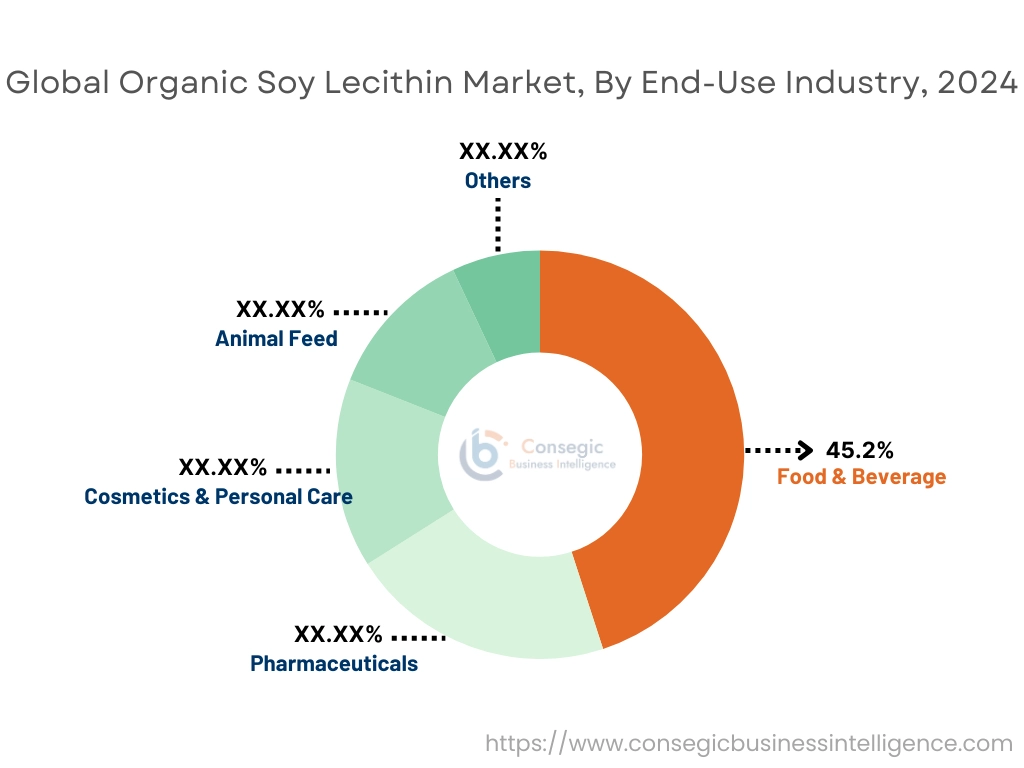
Regional Analysis:
The regions covered are North America, Europe, Asia Pacific, the Middle East and Africa, and Latin America.
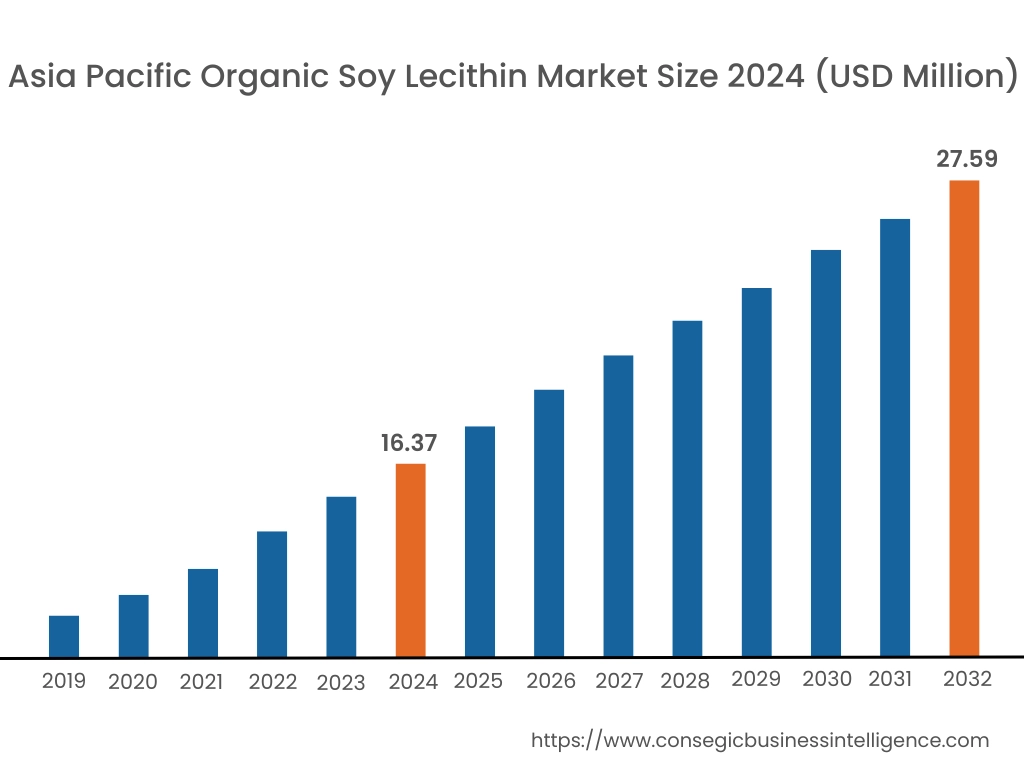
Asia Pacific region was valued at USD 16.37 Million in 2024. Moreover, it is projected to grow by USD 17.17 Million in 2025 and reach over USD 27.59 Million by 2032. Out of this, China accounted for the maximum revenue share of 40.6%. Asia-Pacific is witnessing rapid growth in the organic soy lecithin industry, driven by increasing urbanization, evolving dietary preferences, and the expanding health-conscious middle class. Countries like China, Japan, India, and Australia are increasingly adopting organic ingredients across food manufacturing, baby nutrition, and personal care products. Market analysis points to a rising preference for non-GMO, allergen-free emulsifiers that enhance shelf stability and texture without synthetic additives. Growth is further supported by increasing investments in organic farming practices and the rising influence of Western food trends promoting natural and organic products.
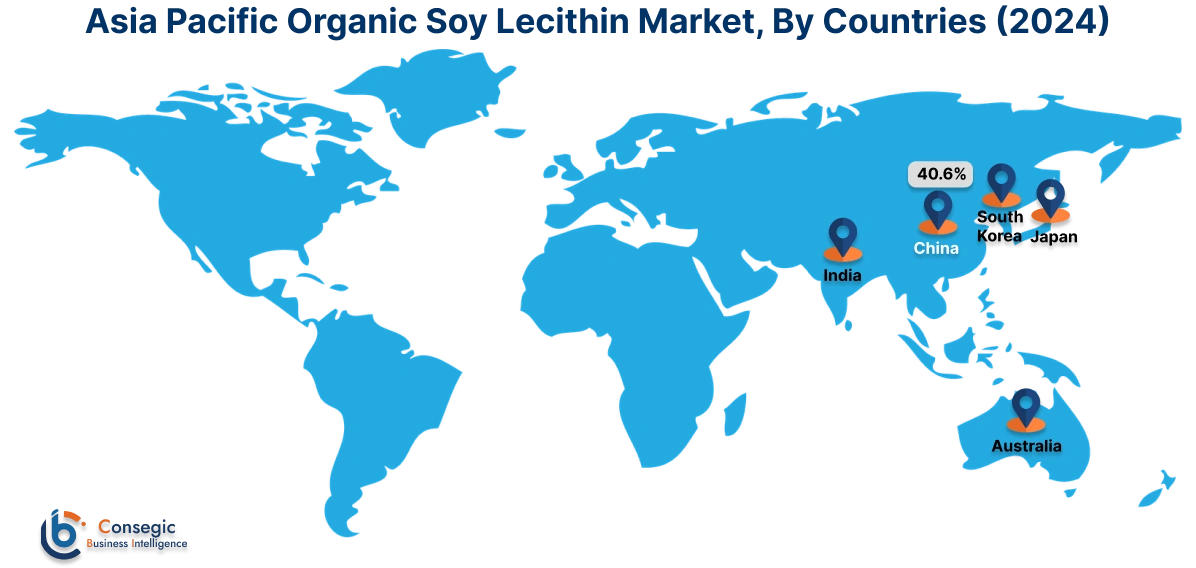
North America is estimated to reach over USD 33.48 Million by 2032 from a value of USD 20.10 Million in 2024 and is projected to grow by USD 21.06 Million in 2025. North America stands as a leading market, supported by robust need for clean-label food products and plant-based alternatives. The United States and Canada are seeing increasing use of organic soy lecithin in bakery, confectionery, and nutraceutical sectors. Market analysis highlights that food manufacturers are prioritizing organic emulsifiers to align with consumer expectations for transparency and sustainability. Expansion in this region is fueled by the surge in vegan and non-GMO product launches, alongside regulatory frameworks favoring organic certifications. The expanding organic food sector and continued innovation in functional foods further enhance the importance of organic emulsifiers.
Europe represents a highly regulation-driven and quality-conscious organic soy lecithin market, especially in countries such as Germany, France, and the Netherlands. Market analysis shows rising need for organic emulsifiers in premium chocolate, dairy alternatives, and dietary supplements, where product purity and traceability are critical. Growth is influenced by stringent EU organic standards and increased investment in organic supply chains. The market opportunity in Europe is closely linked to the region’s strong emphasis on sustainability, ethical sourcing, and consumer awareness regarding clean processing methods in both the food and pharmaceutical industries.
Latin America is gradually adopting organic soy lecithin, with Brazil, Argentina, and Mexico leading regional demand. Market analysis indicates that food and beverage manufacturers are incorporating organic emulsifiers to cater to niche consumer segments seeking certified organic and clean-label products. Increase is facilitated by the expansion of organic farming practices and the growing domestic consumption of natural and health-focused products. The organic soy lecithin market opportunity in this region is enhanced by trade agreements that promote organic exports and the presence of a strong agricultural base capable of supporting organic soy cultivation.
The Middle East and Africa are emerging markets, with requirement concentrated in the UAE, South Africa, and parts of North Africa. Market analysis shows a growing interest in organic and health-promoting ingredients for functional foods, personal care formulations, and dietary supplements. The upward trend is fueled by rising health awareness, increasing availability of organic-certified products, and the entry of multinational organic brands into the regional market. While challenges such as limited local production persist, expanding distribution networks and consumer education initiatives are helping to drive market penetration.
Top Key Players and Market Share Insights:
The organic soy lecithin market is highly competitive with major players providing products and services to the national and international markets. Key players are adopting several strategies in research and development (R&D), product innovation, and end-user launches to hold a strong position in the global organic soy lecithin market. Key players in the organic soy lecithin industry include -
- Cargill (United States)
- Archer Daniels Midland Company (United States)
- Ceresking Ecology & Technology Co., Ltd. (China)
- GIIAVA Pvt Ltd (India)
- NOW Foods (United States)
- Denofa (Norway)
- Lasenor (Spain)
- Lipoid GmbH (Germany)
- DuPont de Nemours, Inc. (United States)
- Ruchi Soya Industries (India)
Recent Industry Developments :
Acquisitions:
- In September 2021, AAK acquired the lecithin business BIC Ingredients, a subsidiary of BIC International Holding. This acquisition expands AAK’s presence in the European market and bolsters its vision of becoming one of the global leading suppliers of lecithin.
Partnerships:
- In January 2022, SEPPURE and GIIAVA partnered to build the world’s first commercial-scale membrane facility for soy lecithin processing. They signed a Memorandum of Understanding (MoU) to implement SEPPURE's industrial-scale nanofiltration membrane technology for the decarbonization of soy lecithin manufacturing. This involves SEPPURE designing, fabricating, and integrating its nanofiltration membrane technology onto a process skid that interface directly with existing process lines in GIIAVA’s soy lecithin facility in Singapore. The industrial nanofiltration system will be equipped with sensors and data processing capabilities to monitor performance and ensure optimal operation over the lifetime of the asset.
Organic Soy Lecithin Market Report Insights:
| Report Attributes | Report Details |
| Study Timeline | 2019-2032 |
| Market Size in 2032 | USD 100.51 Million |
| CAGR (2025-2032) | 6.6% |
| By Type |
|
| By Form |
|
| By Function |
|
| By End-Use Industry |
|
| By Region |
|
| Key Players |
|
| North America | U.S. Canada Mexico |
| Europe | U.K. Germany France Spain Italy Russia Benelux Rest of Europe |
| APAC | China South Korea Japan India Australia ASEAN Rest of Asia-Pacific |
| Middle East and Africa | GCC Turkey South Africa Rest of MEA |
| LATAM | Brazil Argentina Chile Rest of LATAM |
| Report Coverage |
|
Key Questions Answered in the Report
How big is the Organic Soy Lecithin Market? +
Organic Soy Lecithin Market size is estimated to reach over USD 100.51 Million by 2032 from a value of USD 60.46 Million in 2024 and is projected to grow by USD 63.35 Million in 2025, growing at a CAGR of 6.6% from 2025 to 2032.
What specific segmentation details are covered in the Organic Soy Lecithin Market report? +
The Organic Soy Lecithin market report includes specific segmentation details for type, form, function and end-use industry.
What are the end-use industries of the Organic Soy Lecithin Market? +
The end-use industries of the Organic Soy Lecithin Market are food & beverage, pharmaceuticals, cosmetics & personal care, animal feed, and others.
Who are the major players in the Organic Soy Lecithin Market? +
The key participants in the Organic Soy Lecithin market are Cargill (United States), Archer Daniels Midland Company (United States), Denofa (Norway), Lasenor (Spain), Lipoid GmbH (Germany), DuPont de Nemours, Inc. (United States), Ruchi Soya Industries (India), Ceresking Ecology & Technology Co., Ltd. (China), GIIAVA Pvt Ltd (India) and NOW Foods (United States).
